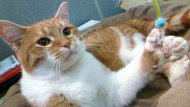
Cat's 26 toes help boost Milwaukee animal shelter

Solutions to Common Pet Problems - How to handle your pets’ most annoying habits and show them (nicely) who’s boss.
Problem: Your Cat Tosses Food on the Kitchen Floor
Why it happens: Kitty might be implying she doesn’t like her bowl. “If it’s made of plastic, she’s right,” says Julia Szabo, author of Animal House Style. “Plastic harbors bacteria and imparts an off-putting taste to food and water.” Or she may just be playing with her food―it’s a game.Problem: Your Cat Scratches Everything
Once he has adapted to the post, move it to a place that’s less intrusive to your design scheme.What to do: Temporarily limit his access to furniture and find him the scratching post of his dreams, suggests Shain. “Some cats like sisal or carpeted posts―even cheap cardboard posts work for many,” she says. “Also, different cats scratch differently. Some want something flat on the ground. Others like to stretch up.” The key is to put the post right next to the piece of furniture he’s ruining until he learns what is OK to scratch and what isn’t.
Problem: Your Cat Meows at Night
What to do: If mating is the motive, promptly “fix” your pet. If not, test the cat for hyperthyroidism with a simple blood test. Treatment options are surgery, daily medication, or radioactive-iodine therapy. A change in diet may also help. “Antioxidants and vitamins E and C may reverse brain-aging changes,” says Moser. Once you rule out medical issues and outside disturbances, you’re probably dealing with a cat who wants attention at 3 a.m. Shain suggests giving the cat some nighttime-only toys before you hit the sack. “It’s a test of will, so steel your nerves and ignore her,” she says.
Problem: Your Pet Sheds
What to do: The first line of defense is to groom your pet for five minutes a day. To reduce shedding, try moisturizing your pet’s skin and hair through his diet. “Dry skin sheds more hair. Dry hairs drop off animals like the needles off a Christmas tree,” says Szabo. She recommends adding a few drops of olive or flaxseed oil to your cat’s or dog’s kibble. Your veterinarian might suggest a dietary supplement such as Derm Caps, which include fish and safflower oils and vitamin E, to improve coat condition. When it comes to cleanup, Szabo swears by the Dyson DC17 Animal, a vacuum designed for a hairy home, and StickySheets, which provide the fuzz-lifting action of a lint roller for a larger surface area.
Problem: Your Cat Claws at a Caretaker
What to do: “Slowly introduce the pet to the visitor so the cat will feel more comfortable with her at vacation time,” says Kathy Kwieran, founder of Kathy's Kitties, a cat-rescue and fostering facility in Kempner, Texas. “The caretaker shouldn’t pet or pick up the cat but should let the cat approach her.
Problem: Your Pet's Poop Adheres to Her Backside
What to do: “Try a more digestible diet to result in a small amount of firm, dark-colored stool that won’t stick to fur,” says Moser. “Look for a cat food that is 32 to 33 percent protein, 12 to 14 percent fat, and relatively low-fiber. For a dog, you want the protein level at 22 to 24 percent, fat around 12 to 14 percent, and low-fiber, low-residue.” If you still have a sticky situation, carefully crop the fur around the rear end with a beard trimmer or nose-hair scissors, or have a groomer do it.
Things your pet shouldn't eat
Listed here, from most (1) to least (4) dangerous, are common foods and drinks that make pets sick. If you think your dog, cat, or bird has consumed one of these items and you are concerned, contact your veterinarian.

1. Chocolate
Why: Stimulates the nervous system and the heart. Poisonous to: All species, but dogs are most likely to eat dangerous quantities. Possible effects of poisoning: Vomiting, increased thirst, restlessness, agitation, increased or irregular heartbeat, increased body temperature, tremors, seizures.

2. Grapes, Raisins
Why: Damage the kidneys. Poisonous to: Dogs, cats. Possible effects of
poisoning: Increased thirst, increased urination, lethargy, vomiting.
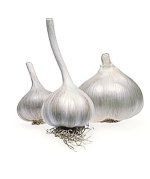 3. Garlic, Onions
3. Garlic, Onions
Why: Damage red blood cells, causing anemia. Poisonous to: Cats, dogs. Possible effects of poisoning: Vomiting, red-colored urine, weakness, anemia.
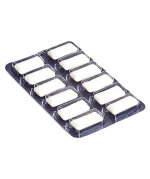 4. Xylitol (Found in sugarless gum.) Why: Causes increased insulin secretion, resulting in lower blood sugar levels. Poisonous to: Dogs. Possible effects of poisoning: Vomiting, lethargy, lack of coordination, seizures, jaundice, diarrhea.
4. Xylitol (Found in sugarless gum.) Why: Causes increased insulin secretion, resulting in lower blood sugar levels. Poisonous to: Dogs. Possible effects of poisoning: Vomiting, lethargy, lack of coordination, seizures, jaundice, diarrhea.
Below are more things that pets shouldn't eat :

5. Alcoholic Drinks
Why: Depress the nervous system.Poisonous to: All species.
Possible effects of poisoning: Vomiting, disorientation, diarrhea, lethargy, lack of coordination, difficulty breathing, tremors, coma, seizures.

6. Raw Yeast, Bread Dough
Why: Forms gas in the digestive track; fermentation of yeast causes alcohol poisoning.Poisonous to: All species, but only dogs typically ingest it.
Possible effects of poisoning: Distention of abdomen, vomiting, disorientation, diarrhea, lethargy, lack of coordination, difficulty breathing, tremors, coma, seizures.

7. Macadamia Nuts
Why: Cause muscle and nervous-system problems.Poisonous to: Dogs.
Possible effects of poisoning: Vomiting, lethargy, weakness, increased body temperature, tremors.
 8. Avocados
8. Avocados
Why: Contain persin, which damages the heart muscle.Poisonous to: Most species―birds are especially sensitive.
Possible effects of poisoning: Vomiting, diarrhea (in dogs), lethargy, difficulty breathing (in birds and rodents).
HUKUM JUAL BELI KUCING...?
Assalamualaikum...
Berkat Sedekah Kepada Kucing... Meeooowwww~~
Assalamualaikum..
Da lama rasanya aku tak update blog ni kan? huhu kemalasan melanda diri..hik3... ni tengah rajin ni meh aku nak citekan satu kisah yanga terjadi pada zaman dahulu mengenai berkatnya bersedekah walaupun pada seekor kucing..
Syaikh Abdul Hadi adalah seorang imam di sebuah masjid di Syria. Pada suatu hari anaknya jatuh sakit. Sudah puas dia berusaha mengubatnya tetapi tidak juga sembuh. Hatinya sedih kerana dia seperti orang lain amat menyayangi anaknya itu.
Sudah puas dia memikirkan apa yang patut dilakukan tetapi pada masa yang sama meneruskan solatnya. Ketika dia ingin mengambil wuduk, dia teringat firman ALLAH S.W.T "Dan mintalah pertolongan (kepada ALLAH) dengan sabar dan (mengerjakan) solat", Al-Baqarah, ayat 45. Syaikh Abdul Hadi juga teringat pada sebuah hadis dari Abu Umamah Al-Bahili r.a, yang menyebut.. sabda Rasulullah S.A.W, "Ubatlah orang yang sakit di antara kalian dengan sedekah"
Syaikh Abdul Hadi termenung dan timbul pertanyaan kepada siapa beliau harus bersedekah pada lewat malam? Siapa yang akan menerima sedekahnya? Tanpa diduga ALLAH S.W.T segera mengirim jawapan apabila Syaikh Abdul Hadi mendengar suara kucing kelaparan. Dia pulang ke rumah dan mengambil sekeping daging. Bukankah menolong haiwan juga bersedekah? Dia memberi daging itu pada kucing yang lapar tadi.
Apabila pulang ke rumah, isterinya bercerita "ketika anaknya yang tidak sihat itu berada dalam gendongannya, tiba-tiba seekor burung besar berwarna hitam datang dari arah langit untuk menyambarnya. Saya terus memeluknya tanpa berfikir panjang apa yang patut dilakukan. Namun, secara tiba-tiba datang seekor kucing yang menerkam. Burung itu terbang lari."
Syaikh Abdul Hadi tersenyum gembira. Keesokannya denga izin ALLAH, anaknya sihat dan mula boleh bermain-main bersama kawannya. Itu tentunya berkat sedekah kepada kucing.
Moral of the story, tak rugi kalo kita bersedekah walaupun untuk seekor kucing...
Kucing Berkaki Bionik
Assalamualaikum..
Meh korang tgk video ni.. terpegun.. beruntungnye catty ni..
Hukum Memandulkan Kucing Dalam Islam
Assalamualaikum..
Khilaf di kalangan Ulama
Therefore, we say that if there is some benefit in neutering the cat and if that will not cause its death, then it is permissible.Dipetik dari IslamOnline.com
Fatwa Jakim Mengenai Mengembirikan Binatang Peliharaan
Bahawa mengembiri binatang kesayangan seperti kucing atau anjing hukumnya adalah diharuskan dengan sebab-sebab tertentu iaitu bagi menjaga muslahat ummah.All pets like cats and dogs are allowed to be neutered or spayed in order to maintain the health and welfare of both the animals and the community.After studying the messages of the aforementioned mazhab's and the medical viewpoint, JAKIM has decided that neutering of cats for reasons of 'maslahat' is acceptable. It is in agreement with 'qaedah' (way) Fiqhiyyah which states "To choose the lesser of two evils".Dipetik dari FelineMalaysia.com
Lagi Cerita PETKNODE a.k.a PETHELL.. "Kucing Mangsa Ketamakkan Manusia"
Assalamualaikum...
Kes PETKNODE a.k.a PETHELL lum abeh lagi.. ikuti cerita ini..







Video-video Pasal PETKNODE!
Assalamualaikum..
Hai.. saje entry kali ni aku nak post video pasal penganiayaan kucen2 kat PETKNODE.. sebab ada yg belum tau pasal kes ni.. tapi aku tak post byk.. 2 je.. kalo nak tgk yg lagi sadis.. g kat YOUTUBE pastu taip je PETKNODE.. insyaALLAH akan kuar suma penderitaan yg kucen2 tu tanggung selama berada dalam pengurungan PETKNODE a.k.a PETHELL..
Mari menonton..
Seminggu Di Kuala Lumpur..
Assalamualaikum..
Hari ni genaplah seminggu aku di Kuala Lumpur.. Aku lepak-lepak kat umah pakcik aku kat Taman Melawati ni.. Asalnye nak lepak kejap je.. tapi bila sampai ari nak balik Kedah tetibe ada lak panggilan suro aku g intebiu keesokan harinye.. jadi terpaksa la aku cancel. Aku g la intebiu tu ditemani kekasih hati MR.P yg amat sabar menunggu sampai abeh intebiu.. (bertambah sayang kat dia... hik3)
Esok pun aku ada intebiu jugak.. tapi tah lah.. amoi yg call aku ni tade lak emel bg alamat kat aku.. ari tu call janji nak emel alamat kat aku.. tunggu punya tunggu tade pun.. esok da nak g intebiu ni.. ape cer kan? so sok aku call dia lah.. kalo tade jugak nampaknye aku hanya akan bersiar-siar di kota yg sesak bersama insan tersayang .. sape lagi kalo bukan MR.P ...keh3 dok kat cni pun kerap dating gak.. hek3 ye le.. da la dok jauh2.. masa ni la amik kesempatan tuk dating kannnn? tak gitu? heh! pas intebiu aku da nak balik kedah.. aduii.. seminggu bersama kekasih hati.. rasa sedih lak nak balik kedah.. tapi ape leh wat.. kena balik jg sebab aku masih ada tanggungjawab aku kat sana... :( tanggungjawab yang takkan putus sampai aku jadi bini org :( tapi aku tade la kejam sampai cam tu... aku anggap tanggungjawab aku ni takkan putus sampai mati.. sampai aku yang mati!! (anak solehah kan aku ni? heh!)
Hmm.. da tade mende nak bebel2 lagi.. aku cuma berharap dan berdoa agar aktiviti lepak2 aku kat cni membuahkan hasil.. AMINNNN...
Berdoa dan bertawakal kepadaNya
Cat Scratching - How To Stop Your Cat Scratching The Furniture
Assalamualaikum..
Why do cats scratch?
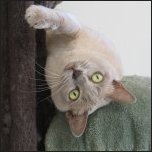 Scratching (also known as stropping) is a normal behaviour in cats. Unfortunately some cats can cause countless headaches for their owners by scratching household furnishings, which leads to damage & great expense. Scratching of furniture is a leading cause of cats being surrendered to shelters.
Scratching (also known as stropping) is a normal behaviour in cats. Unfortunately some cats can cause countless headaches for their owners by scratching household furnishings, which leads to damage & great expense. Scratching of furniture is a leading cause of cats being surrendered to shelters.How to stop scratching:
- For some owners declawing (which is prohibited in most countries) is their chosen method to prevent scratching. This is a rather painful operation which involves amputation of the cat's claw up to the first joint. The majority of people strongly disagree with declawing of cats for a multitude of reasons. It is painful & unnecessary, it can also lead to other behavioural problems such as biting & inappropriate urination. Also, cats derive great pleasure from scratching & declawing deprives them of this pleasure. There are many alternative methods which are far kinder than declawing, which is really only performed for the owner's convenience anyway.
- The plan is to make the current target unpleasant while providing your cat with a more attractive alternative such as a scratching post or cheaper scratching boards which can be hung from a door handle. There's a huge variety on the market which will suit all tastes & budgets. Most scratching posts are covered either in carpet or sisal. If possible, temporarily cover the object your cat is scratching with some thick plastic or double sided tape, which will act as a deterrent.
- Another you may want to consider are water sprays (use when your cat starts scratching the furniture), this may work but it may just stop your cat scratching when you are around.
- You can also try placing orange peel around the location. Many cats find the citrus smell extremely unpleasant.
- Now you need to encourage your cat to use the scratching post provided. You can purchase catnip spray from many pet shops & spray this on the post to attract the cat, or rub some dried catnip on the post. Cats enjoy a scratch after a nap, so try placing the scratching post close to your cat's favoured sleeping location.
- If you see your cat making a beeline for a favourite piece of furniture to scratch on, gently pick up the cat & move it over to the scratching post. If the cat uses it heap plenty of praise on your cat. Cats respond far better to positive behaviour than negative behaviour from their owners.
- Cutting your cat's claws regularly will minimise damage caused to your furniture. For help on trimming your cat's claws read here.
- Never physically punish a cat when you catch it scratching inappropriately. Physical punishment serves no purpose & more often than not has a negative effect on how your cat perceives you. A firm "no" & a spray with the water spray are more effective than smacking your cat.
Cat Trees, Cat Furniture and Cat Scratching Posts
Assalamualaikum..
 Cat trees (also known as cat condos) are structures, usually carpeted, that are used for your cat to sharpen it's claws, play & sleep on. They come in a wide variety of shapes & sizes from a very basic post to giant ones that have multiple posts, perches, platforms, cubby holes, tunnels & toys.
Cat trees (also known as cat condos) are structures, usually carpeted, that are used for your cat to sharpen it's claws, play & sleep on. They come in a wide variety of shapes & sizes from a very basic post to giant ones that have multiple posts, perches, platforms, cubby holes, tunnels & toys.
Scratching (also known as stropping) is a normal behaviour in cats. Unfortunately some cats can cause countless headaches for their owners by scratching household furnishings, which leads to damage & great expense. Scratching of furniture is a leading cause of cats being surrendered to shelters. Providing a cat tree for your cat to use will greatly reduce the chances of household furniture being used.
The larger cat trees offer more than just the opportunity for your cat to scratch. With tunnels, perches & even attachments that will keep your cat entertained for hours. Tall ones can be placed close to windows, providing a spot for your cat to laze in the sun & watch the world go by. This is especially important for indoor only cats. Larger cat trees can also provide your cat(s) with hours of fun playing on & around.
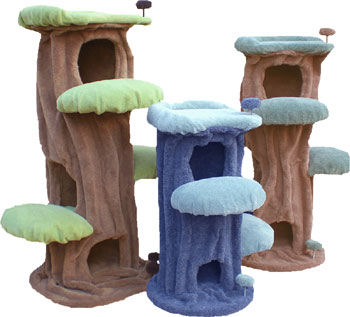
Photo courtesy of Funky Cat
What is the difference between a cat tree & a cat scratching post?
The two are interchangable. A cat tree is also a cat scratching post, but some scratching posts may be very basic & do not provide the opportunity for your cat to climb onto. The smallest cat scratching posts (also known as a cat scratching board) can be hung over a door handle. This is especially useful if you live in a small flat or apartment where space is limited.
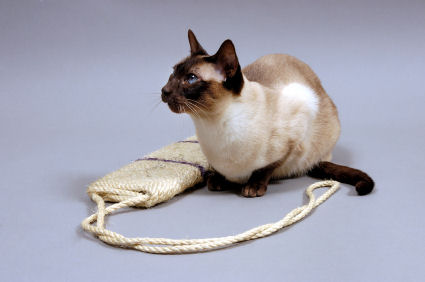
Which cat tree should I buy?
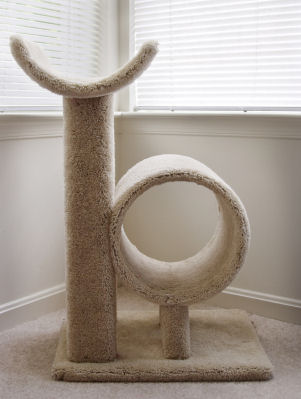 You are only limited by size, budget & the number of cats you have. A basic pole may be all that is required for one cat, but if you have multiple cats a larger cat tree is preferable, these come with multiple posts & different ledges for your cats to use. Look for a sturdy looking structure, which is made of good quality, long lasting products to keep your cats happy for many years to come. Aim to have one that your cat can fully stretch out on from a standing position. It is a way of loosening up leg & shoulder muscles & tendons in the cat's paws.
You are only limited by size, budget & the number of cats you have. A basic pole may be all that is required for one cat, but if you have multiple cats a larger cat tree is preferable, these come with multiple posts & different ledges for your cats to use. Look for a sturdy looking structure, which is made of good quality, long lasting products to keep your cats happy for many years to come. Aim to have one that your cat can fully stretch out on from a standing position. It is a way of loosening up leg & shoulder muscles & tendons in the cat's paws.
For the DIY enthusiast, there are many sites on the Internet that offer free instructions to build your own.
Funky Cat products are a favourite among Australian cat lovers. Not only are they incredibly sturdy, but they look fantastic too.
Where to buy a cat tree:
Pet shops, online & specialist cat tree manufacturers are the best places to buy a cat tree.
Training your cat to use a cat tree (and not the furniture):
Now you need to encourage your cat to use the scratching post provided. You can purchase catnip spray from many pet shops & spray this on the post to attract the cat, or rub some dried catnip on the post. Cats enjoy a scratch after a nap, so try placing the scratching post close to your cat's favoured sleeping location.
Cat trees can be purchased from most pet shops or online. If space permits, I would recommend you buy a larger one, which also provides your cat with a perch to sit & sleep on. The larger the better, especially if you have more than one cat.
Cat Claws - Anatomy, Care & Disorders of the Cat Claw
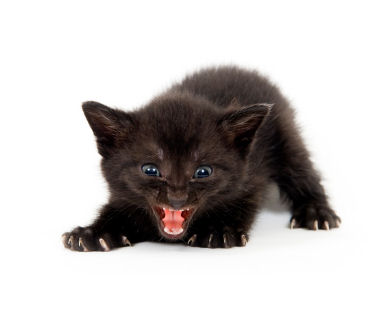

- Pemphigus an autoimmune disease may affect the claws
- Systemic lupus erythematosus may affect the claws
- Bacterial infection
- Onychomycosis (fungal infection of the claw & clawbed)
- Trauma (tearing etc)
Nail (claw) biting in cats:
Declawing:
A procedure carried out in the US & Canada, declawing is performed for non medical reasons to prevent the cat scratching furniture or family members (both pet & human).
- Bleeding
- Infection
- Bone protrusion into the pad of the paw *
- Lameness
- Behavioural problems such as biting & litter box problems
- Providing your cat with a cat tree/scratching post & working with the cat to encourage it to use that instead of your furniture. If space is a problem, you can buy small scratching posts that you hang over door handles that take up no room at all. For more information on training your cat to use a scratching post, read here.
- Using Soft Claws.
- Trimming your cat's claws regularly.
How to stop scratching:
- For some owners declawing (which is prohibited in most countries) is their chosen method to prevent scratching. This is a rather painful operation which involves amputation of the cat's claw up to the first joint. The majority of people strongly disagree with declawing of cats for a multitude of reasons. It is painful & unnecessary, it can also lead to other behavioural problems such as biting & inappropriate urination. Also, cats derive great pleasure from scratching & declawing deprives them of this pleasure. There are many alternative methods which are far kinder than declawing, which is really only performed for the owner's convenience anyway.
- The plan is to make the current target unpleasant while providing your cat with a more attractive alternative such as a scratching post or cheaper scratching boards which can be hung from a door handle. There's a huge variety on the market which will suit all tastes & budgets. Most scratching posts are covered either in carpet or sisal. If possible, temporarily cover the object your cat is scratching with some thick plastic or double sided tape, which will act as a deterrent.
- Another you may want to consider are water sprays (use when your cat starts scratching the furniture), this may work but it may just stop your cat scratching when you are around.
- You can also try placing orange peel around the location. Many cats find the citrus smell extremely unpleasant.
- Now you need to encourage your cat to use the scratching post provided. You can purchase catnip spray from many pet shops & spray this on the post to attract the cat, or rub some dried catnip on the post. Cats enjoy a scratch after a nap, so try placing the scratching post close to your cat's favoured sleeping location.
- If you see your cat making a beeline for a favourite piece of furniture to scratch on, gently pick up the cat & move it over to the scratching post. If the cat uses it heap plenty of praise on your cat. Cats respond far better to positive behaviour than negative behaviour from their owners.
- Cutting your cat's claws regularly will minimise damage caused to your furniture. For help on trimming your cat's claws read here.
- Never physically punish a cat when you catch it scratching inappropriately. Physical punishment serves no purpose & more often than not has a negative effect on how your cat perceives you. A firm "no" & a spray with the water spray are more effective than smacking your cat.
Claw care:
Cat claws continually grow. They are usually worn down during outdoor activity such as climbing & scratching. Indoor cats may keep their claws short by using a cat tree/scratching post. However, older cats, or cats without a scratching post can develop overgrown claws. It is important to keep your cat's claws trimmed to avoid overgrown claws which can result in injury, or in the case of my old & arthritic cat, the claws growing into the foot pad.

 Will Love Them Till My Last Breath ...
Will Love Them Till My Last Breath ...









